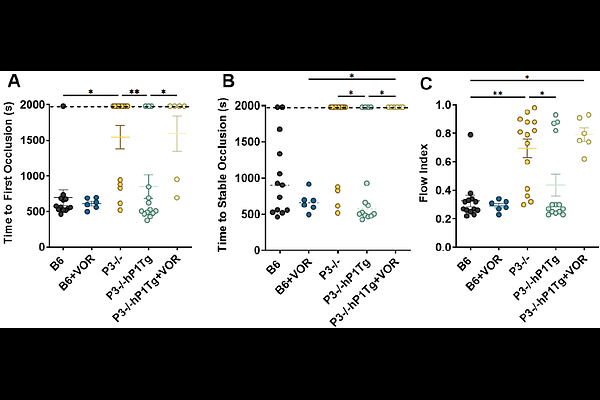Human PAR1 expressed on mouse platelets contributes to hemostasis and arterial occlusion

Human PAR1 expressed on mouse platelets contributes to hemostasis and arterial occlusion
Kanaji, S.; Zarpellon, A.; Aiolfi, R.; Morodomi, Y.; Orje, J.; Zampolli, A.; Won, E.; Ruggeri, Z. M.; Kanaji, T.
AbstractThrombin (FIIa) signaling through protease-activated receptors (PARs) is a relevant platelet activation mechanism. Human (h) PAR1 antagonists are approved for antithrombotic therapy, but bleeding is a concerning complication. In addition to PARs, platelet glycoprotein (GP) Ib also binds FIIa, enhancing human platelet response to lower agonist concentrations ex vivo. Signaling through GPCRs is well understood, but how GPIb association with distinct PARs modulates FIIa-dependent platelet activation in vivo remains unclear. One obstacle in addressing this question is the distinct human platelet PAR1/PAR4 expression as opposed to mouse (m) PAR3/PAR4. Previous attempts to express functioning hPAR1 in mouse platelets using platelet-specific promoters or targeting into the mPAR3 locus have not been successful. Here we report our studies using a hPAR1 transgene with a floxed STOP sequence and strong synthetic (CAG) promoter targeted into the mouse Rosa26 locus. Generated Rosa26-hPAR1Tgfl mice were then sequentially crossbred with PF4-Cre and PAR3-/- mice, yielding mP3-/-hP1Tg mice whose platelets expressed hPAR1 with endogenous mPAR4. These mice, unlike PAR3-/-, had no excessive bleeding after tail clipping, but bled profusely after administration of the hPAR1 antagonist, vorapaxar. Accordingly, mP3-/-hP1Tg mice had more frequent and stable post-injury occlusion of the carotid artery than PAR3-/- mice, but this difference was abolished by vorapaxar treatment. We anticipate that studies in this mouse strain will help unravel the regulation of PAR-mediated thrombin-induced platelet activation in vivo with findings more directly relevant to human pathophysiology.